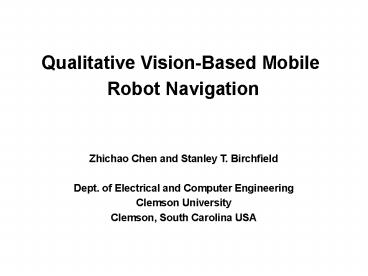Qualitative Vision-Based Mobile Robot Navigation PowerPoint PPT Presentation
Title: Qualitative Vision-Based Mobile Robot Navigation
1
Qualitative Vision-Based Mobile Robot Navigation
- Zhichao Chen and Stanley T. Birchfield
- Dept. of Electrical and Computer Engineering
- Clemson University
- Clemson, South Carolina USA
2
Motivation
- Goal Enable mobile robot to follow a desired
trajectory in both indoor and outdoor
environments - Applications courier, delivery, tour guide,
scout robots - Previous approaches
- Image Jacobian Burschka and Hager 2001
- Homography Sagues and Guerrero 2005
- Homography (flat ground plane) Liang and Pears
2002 - Man-made environment Guerrero and Sagues 2001
- Calibrated camera Atiya and Hager 1993
- Stereo cameras Shimizu and Sato 2000
- Omni-directional cameras Adorni et al. 2003
3
Our approach
- Key intuition Vastly overdetermined
system(Dozens of feature points, one control
decision) - Key result Simple control algorithm
- Teach / replay approach using sparse feature
points - Single, off-the-shelf camera
- No calibration for camera or lens
- Easy to implement (no homographies or Jacobians)
4
Preview of results
5
Tracking feature points
- Kanade-Lucas-Tomasi (KLT) feature tracker
- Automatically selects features using eigenvalues
of 2x2 gradient covariance matrix - Automatically tracks features by minimizing sum
of squared differences (SSD) between consecutive
image frames - Augmented with gain and bias to handle lighting
changes - Open-source implementation
gradient of image
unknown displacement
gray-level images
http//www.ces.clemson.edu/stb/klt
6
Handling lighting changes
original KLT tracker
modified KLT tracker
original KLT tracker
modified KLT tracker
original
modified
original
modified
Environmental conditions due to clouds blocking
sun
Automatic gain control of the camera
7
Teach-Replay
track features
detect features
destination
Teaching Phase
start
compare features
track features
Replay Phase
8
Qualitative decision rule
Landmark
feature
image plane
Robot at goal
uGoal
uCurrent
funnel lane
No evidenceGo straight
Feature is to the right uCurrent gt uGoal?
Turn right
Feature has changed sides sign(uCurrent) ?
sign(uGoal) ? Turn left
9
The funnel lane at an angle
Landmark
feature
image plane
Robot at goal
funnel lane
No evidenceGo straight
Feature is to the right? Turn right
Side change? Turn left
10
The funnel lane created by multiple feature points
Landmark 2
Landmark 1
Landmark 3
ambiguous area
a
a
Feature is to the right? Turn right
No evidenceDo not turn
Side change? Turn left
11
A simplified example
Landmark
feature
Robot at goal
funnel lane
funnel lane
funnel lane
funnel lane
Go straight
Go straight
Go straight
Turn right
Turn left
Go straight
12
Qualitative control algorithm
uCurrent
Funnel constraints
uGoal
uGoal
- Voting scheme
- Each feature votes either
- turn right, or
- turn left
- Majority rules
End of segment reached When the mean squared
error increases
13
Experimental results
Videos available at http//www.ces.clemson.edu/st
b/research/mobile_robot
14
Experimental results
Videos available at http//www.ces.clemson.edu/st
b/research/mobile_robot
15
Experimental results
Indoor
Outdoor
Imaging Source Firewire camera
Logitech Pro 4000 webcam
16
Conclusion
- Approach
- teach-replay, comparing image coordinates of
feature points - qualitative decision rule (no Jacobians,
homographies) - Advantages
- off-the-shelf camera
- no calibration (not even lens distortion)
- simple, easy to implement
- tested in both indoor and outdoor environments
- Future work
- variable driving speed (sharp turns)
- integration with other sensors (odometry, GPS)
- obstacle avoidance

